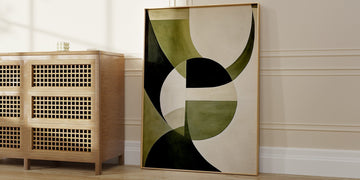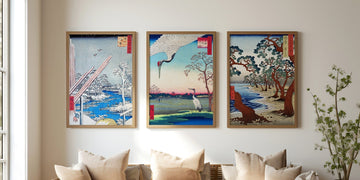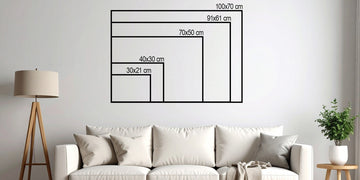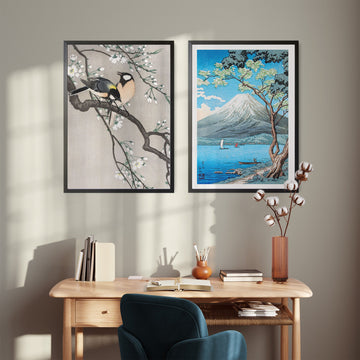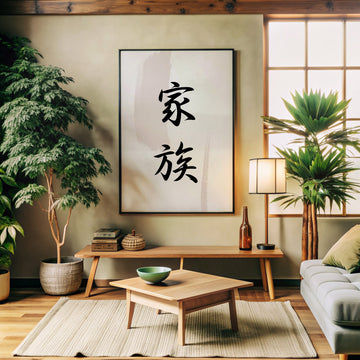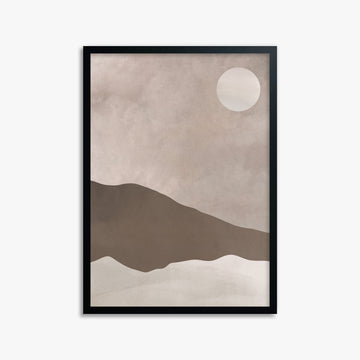Ever bought a beautiful print, hung it on your wall, and felt like something was... off? The artwork is gorgeous, the placement is perfect, but it just doesn't have that polished, intentional look you see in magazines or carefully curated Instagram posts. Plot twist: it's probably not the art - it's the frame.
Here's the thing about frames that most people don't realize: they're not just protective borders around your artwork. They're like the perfect accessory that can make or break your entire look. A cheap, flimsy frame can make even the most expensive art look amateur, while a quality frame can elevate a simple print into something that looks like it belongs in a gallery.
If you've ever wondered why some wall displays look effortlessly professional while others feel a bit... DIY disaster, this guide will decode the mysterious world of picture frames and help you understand how to choose frames that actually enhance your space instead of detracting from it.
What Actually Makes a Frame "Good" vs. "Cheap"?
Not all frames are created equal, and the difference isn't always obvious at first glance. But trust us - after a few months on your wall, you'll definitely notice the difference between quality construction and corner-cutting manufacturing.
Quality frame characteristics
Solid wood construction
- Made from hardwood that won't warp, bend, or crack over time
- Clean, precise corners that stay tight
- Consistent thickness and smooth finish
- European sourced wood with sustainable practices

Professional-grade components
- Plexiglass front panel instead of real glass (safer and lighter)
- MDF backing board for stability and moisture resistance
- Quality hanging hardware that won't fail
- Proper depth for secure mounting (2.5cm from wall)
Precision manufacturing
- Accurate measurements that fit your artwork perfectly
- Smooth edges and consistent color
- Joints that won't separate over time
Cheap frame warning signs
Soft wood that bends easily
- Made from pine or other soft woods that warp
- Corners that separate after a few months
- Visible wood grain showing through paint
- Inconsistent thickness

Flimsy components
- Thin, cheap glass that breaks easily
- Cardboard backing that warps with humidity
- Plastic clips that break during installation
- Hardware that fails under weight
How Do Different Frame Styles Transform Your Artwork?
The style of frame you choose completely changes how people perceive your artwork. It's like choosing between wearing sneakers or dress shoes with the same outfit - same outfit, totally different vibe.

Minimalist Modern Frames
- Clean lines, simple profiles - Let the artwork be the star
- Neutral colors (black, white, natural wood) work with any decor
- 2cm width provides presence without overwhelming
- Perfect for: Contemporary art, photography, botanical prints, abstract pieces
Ornate Traditional Frames
- Decorative details and wider profiles - Make a statement alongside the art
- Rich colors and textures - Add luxury and formality
- Best for: Classical art, vintage prints, formal dining rooms
Industrial/Raw Frames
- Metal construction or distressed wood - Add edge and texture
- Darker, moodier tones - Create dramatic contrast
- Perfect for: Urban lofts, masculine spaces, photography
Floating Frames
- Artwork appears to "float" within the frame - Modern, gallery-like effect
- Minimalist aesthetic - Focus entirely on the art
- Best for: Canvas prints, contemporary pieces
Why Frame Width and Depth Actually Matter More Than You Think
Here's something most people don't consider: the physical dimensions of your frame affect both the visual impact and practical functionality of your wall art.
Frame width (the visible border)
- Thin frames (1-2cm) - Subtle, let artwork dominate
- Medium frames (2-4cm) - Balanced presence, work with most art
- Wide frames (5cm+) - Make a statement, require larger wall space

Frame depth (distance from wall)
- Shallow frames (1-2cm) - Sit close to wall, minimal shadow
- Standard depth (2.5cm) - Professional look with subtle dimension
- Deep frames (3cm+) - Create dramatic shadows and presence
Why 2cm width and 2.5cm depth work perfectly: This combination provides enough visual weight to look intentional and professional without overwhelming smaller artworks. The depth creates subtle shadows that add dimension, while the width provides a clean border that works with any interior style.
What's the Deal with Glass vs. Plexiglass?
This is where a lot of people get confused. "Isn't real glass better?" Actually, no - especially for home use. Here's why plexiglass is often the superior choice:
Plexiglass advantages
- Lighter weight - Easier to hang, less stress on wall anchors
- Shatter-resistant - No dangerous glass shards if broken
- UV protection - Many types filter harmful light
- Clearer optics - Less green tint than regular glass
- Easier shipping - Won't break in transit
When real glass makes sense
- Museum-quality conservation framing
- Very large pieces where rigidity matters
- Situations where optical clarity is critical
For home wall art, plexiglass is usually the smarter choice. It's safer around kids and pets, easier to handle during hanging, and provides better protection for your artwork.
Why the Back Panel Material Actually Matters
Nobody sees the back of your frame once it's hung, but the backing material affects your artwork's longevity and the frame's stability.
MDF backing boards
- Stable and flat - Won't warp with temperature changes
- Moisture resistant - Protects artwork from humidity
- Smooth surface - Won't scratch or damage prints
- Consistent thickness - Ensures even pressure on artwork
- Removable design - Secured with flexible metal tabs for easy access if needed
Cardboard/paper backing (avoid these)
- Warps easily - Creates waves in your artwork
- Absorbs moisture - Can cause mold or staining
- Acidic content - Actually damages artwork over time
- Flimsy construction - Doesn't provide proper support
- Difficult replacement - Often glued or stapled permanently
What About the Hanging Hardware?
This is where cheap frames really show their true colors. Nothing's more frustrating than having your beautiful artwork crash to the floor because the hanging system failed.
Quality hanging systems include
- Two metal sawtooth hangers - One positioned for portrait, one for landscape orientation
- Metal D-rings (alternative system) - Distribute weight evenly with dual mounting points
- Appropriate weight rating - Won't fail under normal use
- Secure attachment - Screwed into frame, not just glued
- Flexible metal tabs - Allow easy access to backing for maintenance or artwork changes
Cheap hanging hardware problems
- Single hanging point - Creates stress and instability
- Plastic components - Break under weight or over time
- Poor attachment - Pulls out of soft wood frames
- Wrong placement - Causes artwork to hang crooked
- Permanent backing - Glued or stapled, impossible to access without damage
Our frames come with dual metal sawtooth hangers already installed, positioned specifically for both portrait and landscape orientations. The MDF backing is secured with flexible metal tabs, making it easy to access the interior if needed or even reuse the frame with different artwork in the future.
How Do Frame Colors Affect Your Interior Design?
The color of your frame is like choosing the right foundation shade - get it right, and everything looks polished; get it wrong, and nothing quite works.

Black frames
- Create strong contrast - Make colors pop
- Feel modern and sophisticated - Work with contemporary and industrial styles
- Hide imperfections - Scratches and wear less visible
- Best with: Bright artwork, white walls, modern interiors
White frames
- Blend seamlessly - Especially with white or light walls
- Feel clean and fresh - Perfect for Scandinavian and minimalist styles
- Brighten artwork - Reflect light back onto the piece
- Best with: Soft colors, neutral palettes, bright spaces
Natural wood frames
- Add warmth and texture - Bring organic elements indoors
- Work with multiple styles - From rustic to modern
- Show beautiful grain patterns - Each frame is unique
- Best with: Earth tones, plants, natural materials
How Do You Actually Hang Framed Art Properly?
Once you've got your perfectly framed artwork, hanging it properly makes all the difference between looking professional and looking haphazard.
The easiest hanging method
- Use adhesive picture hanging strips - No tools required, won't damage walls
- Check level with your smartphone - Most phones have built-in level apps
- Position at eye level - Generally 145-150cm from floor to center of frame
- Allow for viewing distance - Hang slightly higher in dining rooms where people are usually seated

Why adhesive hangers are brilliant
- No drilling required - Perfect for renters
- Won't damage walls - Remove cleanly when you move
- Easy to adjust - Reposition without making new holes
- Available everywhere - Any home improvement or DIY store carries them
Traditional hanging with nails/screws
- More secure for heavy pieces - Better for artwork over 1kg
- Permanent solution - Good for long-term placement
- Requires tools - Level, drill, measuring tape
What Are the Most Common Frame Selection Mistakes?
Learning from other people's mistakes can save you time, money, and the frustration of living with artwork that doesn't quite look right.
Mistake #1: Choosing frames that are too small
- The fix: Frame width should feel proportional to artwork size
- Why it matters: Tiny frames make art look unfinished
Mistake #2: Mixing too many frame styles
- The fix: Stick to 2-3 frame colors/styles maximum in one room
- Why it matters: Visual cohesion creates a more polished look
Mistake #3: Buying cheap frames to "save money"
- The fix: Invest in quality frames that will last
- Why it matters: Cheap frames often need replacing within a year
Mistake #4: Not considering the room's style
- The fix: Match frame style to your overall decor aesthetic
- Why it matters: Frames should enhance, not clash with your space
Mistake #5: Ignoring practical considerations
- The fix: Consider lighting, humidity, and traffic in frame placement
- Why it matters: Wrong placement can damage artwork or create glare
How Do Quality Frames Elevate Any Interior Style?
Here's the magic of well-made, thoughtfully designed frames: they work with virtually any interior style because they don't fight for attention - they support and enhance what's already there.
In minimalist spaces: Clean lines and neutral colors maintain the uncluttered aesthetic while adding just enough definition to create visual interest.
In traditional interiors: Quality construction and classic proportions complement established design elements without looking out of place.
In eclectic homes: Consistent frame quality creates cohesion among diverse artwork and decor styles.
In small spaces: Proper proportions and clean design prevent visual clutter while maximizing the impact of your chosen artwork.
Should You Always Buy Frames from Your Poster Store?
Here's the honest truth: while we believe our frames offer excellent quality and value, the most important thing is that you're happy with your choice.
Our frames are perfect if you want
- Professional quality at reasonable prices
- Consistent sizing for European poster standards
- Ready-to-hang convenience
- Modern, minimalist aesthetic
- Reliable, long-lasting construction
Consider local frame shops if you want
- Specialty matting or mounting techniques
- Antique or ornate frame styles
- Unique or one-of-a-kind designs
- Different proportions or finishes
The key is understanding quality markers so you can make informed decisions wherever you shop. Whether you choose our frames or source them elsewhere, look for solid wood construction, quality components, and proper hanging hardware.
Ready to Frame Your Perfect Space?
The right frame doesn't just protect your artwork - it transforms it from a simple print into a polished piece of your home's story. Whether you choose sleek black frames for a modern gallery wall, warm wood frames for a cozy reading nook, or clean white frames for a Scandinavian-inspired space, quality construction ensures your investment will look beautiful for years to come.
Remember: great frames are invisible in the best way. They showcase your artwork, complement your space, and provide reliable protection without drawing attention to themselves. When someone walks into your room and comments on your beautiful wall art, they're seeing the complete picture - artwork and frame working together in perfect harmony.
The next time you're tempted to grab the cheapest frame available, remember that you're not just buying a border for your art. You're investing in the overall look and feel of your space. Choose wisely, and your walls will thank you.
Ready to see the difference quality frames make? Our collection of professional-grade frames in classic black, clean white, and warm natural wood are designed to complement any space and enhance any artwork. Each frame comes ready to hang with dual metal hangers and premium components that ensure your art looks its best for years to come.

